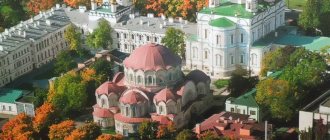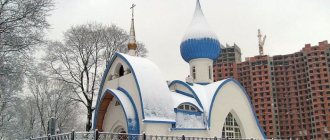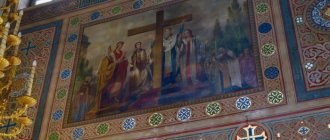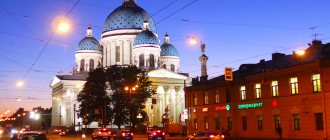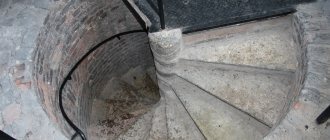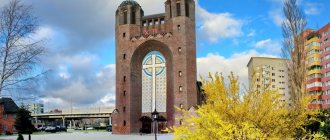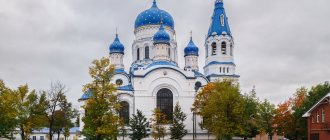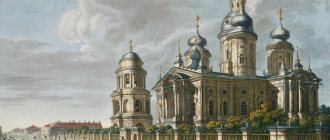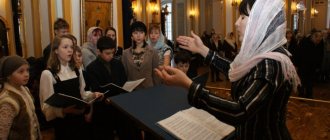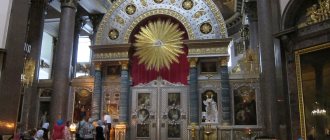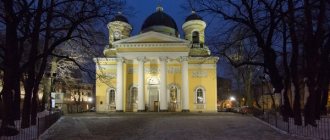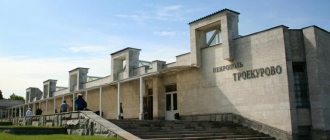Updated 08/19/2021
Smolensk Cemetery in St. Petersburg is a burial place for Orthodox Christians, located in the west of the city, in the center of Vasilyevsky Island. Located next to the Smolenka River, Maly Prospekt and Bering Street. On the territory of the churchyard there are several churches and chapels, mass graves and burial places of famous figures of science and culture. I’ll tell you the history of the cemetery, how it was built, and who is buried here.
History of the cemetery
The appearance of the Smolensk cemetery is associated with the birth of the northern capital of Russia. Initially, a small graveyard was built here for construction workers building stone St. Petersburg. It got its name from the fact that the area of Vasilievsky Island was built up by peasants expelled from the Smolensk province.
The choice of location was unfortunate, since until the 21st century Vasilyevsky Island was regularly flooded. In the 18th-19th centuries, floods were real disasters and led to numerous casualties. In connection with this, the churchyard was also regularly flooded. Wooden crosses and tombstones could float a considerable distance, which led to confusion and the appearance of unmarked graves.
In 1738, burial grounds were officially established here for the first time. In 1809, the first cemetery entrance appeared from Kamskaya (formerly Tserkovnaya) street. Its architectural design was carried out by the architect Aloysius Ivanovich Ruska. He also built a local almshouse consisting of two buildings, intended for orphans and widows.
Cemetery today
In the 19th century, private plots were allocated here for a number of government institutions. These included the Pavlovsk School, the 1st Cadet Corps, the 2nd Cadet Corps, the Mining Institute and others. This is how the names of the paths appeared at the Smolensk Cemetery, along which visitors quickly found their way and got to the graves. For example:
- 1st Cadet track;
- 1st Mountain Path;
- Pavlovskaya path, etc.
They exist to this day, they can be seen on the map of the Smolensk cemetery in St. Petersburg. Later, other named paths appeared that help to navigate the territory of the cemetery. In addition, they allow you to divide it into sections, because the cemetery remains active. Here we offer burial plots: urns, columbarium, prepared plots, burials in a related grave and a fence around a related grave.
- The Smolensk Orthodox Cemetery is located at the address: St. Petersburg, Vasilyevsky Island, Kamskaya Street, 26.
- Open to visitors daily. In summer (from May to September) - from 9:00 to 18:00, in winter (from October to April) - from 9:00 to 17:00.
Arguments and facts: History and legends of the Smolensk cemetery
280 years ago, on November 3, 1738, one of the oldest St. Petersburg cemeteries, Smolenskoye, was organized. During this time, it was not only a place of burials, but also of folk festivals, and its territory was given over for the construction of a nursery and even a park.
Smallpox Cemetery
Burials on Vasilyevsky Island in St. Petersburg began long before the appearance of city cemeteries. They often occurred spontaneously, for example, near the location of the barracks of the Ingria Regiment on the banks of the Black River (now Smolenka). And since Vasilyevsky Island sometimes found itself cut off from the central part of the city by ice, drifting ice, or simply bad weather, its residents were buried near their place of residence, even after special plots were set aside for this - near the Sampsonievskaya Church on the Vyborg side. The first official mention of the territory for burials dates back to 1738, when by decree of the Synod a place for graves was allocated at the “Black River, between the 18th and 23rd lines.”
There are two versions of how the name of the Smolensk cemetery came about. According to the first, from the settlement in which residents of the Smolensk province settled for permanent housing in the newly built St. Petersburg. On the second - from the Church of the Smolensk Icon of the Mother of God. The wooden building was founded on September 30, 1760, and the stone one was erected in 1790. Initially, the church and cemetery were very poor, there was barely enough money for the basic necessities. In order to somehow improve the property situation, in 1772 the cemetery church received the exclusive right to perform funeral services for children who died of smallpox. It was at this time that another name for the church and cemetery appeared - smallpox. Later, this place was also associated with the cholera epidemic of 1831 - then a special plot was allocated in the churchyard for the burial of those who died from this then little-known and terrible disease.
Famous deceased
The priest Grigory Petrov was able to improve the financial situation of both the church and the cemetery in the 80-90s of the 18th century. He not only improved the cemetery, but also achieved the purchase of land on which several houses were built. The income they brought in went to the church and cemetery treasury. Gradually, an infrastructure began to take shape - undertakers' establishments and workshops for making monuments, wreaths and artificial flowers appeared. Often, establishment owners displayed their goods on the street to attract buyers. In addition, Smolensky operated two almshouses, the residents of which provided a number of services for money: they looked after the graves, washed the dead, and worked as mourners.
Since 2008, landscaping work has been carried out as part of an initiative to restore and restore monuments at the graves of prominent figures of the University.
Initially, people of ordinary rank were buried in the cemetery. In 1828, the legendary nanny of Alexander Pushkin, Arina Rodionovna, was also buried. Over time, when Vasilievsky Island became a place of resettlement for teachers and students of the Academy of Arts and the University, many burial places of artists, sculptors, scientists and poets appeared on Smolensky. In 1861, the poet Taras Shevchenko was initially buried here (after 2 months his body was transported to Ukraine), and later Alexander Blok.
Among the famous graves of the cemetery is the grave of Xenia the Blessed - the city's holy fool, elevated by human rumor to the category of saints. Her fame began in the 18th century, when, after the death of her husband, she lost her mind and, dressed in men's clothing, wandered around the city and allegedly predicted various events.
Mosaic on the wall of the Chapel of Xenia the Blessed
Park on the site of the graves
After the revolution, the cemetery and church experienced difficult times, and by the early 1940s they were completely closed. The territory of the cemetery was gradually built up - in 1936, one hectare was given to a neighboring enterprise for the construction of a nursery. In the same year, the idea was born to finally improve the vast territory - to destroy the burial sites and create a park in their place. This is the fate that befell the ancient cemetery on the Vyborg side - Sampsonievskoye. It was decided to move the burials of outstanding people to the necropolis of art masters being created at the Alexander Nevsky Lavra or to the Literary Bridges of the Volkov Cemetery. Since 1931, a long process of transferring burials began.
But during the years of the blockade the situation changed: the dead began to be buried in the cemetery again. After the war, it was decided to transfer the ashes of Alexander Blok to Literatorskie Mostki. On September 26, 1944, employees of the Museum of Urban Sculpture and literary scholars V.S. Spiridonov and D.E. Maksimov placed the ashes of Blok’s relatives, the Beketovs, in special wooden boxes, and then the ashes of the poet himself. There are many rumors surrounding this reburial. In 1994, academician Dmitry Likhachev, in an interview, complained about the ongoing destruction of the Smolensk cemetery and told the following, according to Maksimov: “Blok was reburied in 1944. Dmitry Evgenievich Maksimov was present at this event. And only Blok’s skull was reburied. Dmitry Evgenievich carried him in a scarf and along the way he picked out the earth from his eye sockets with his finger. It seemed to him that it would be better this way. And then they stopped him and said: “You are picking out Blok’s ashes. This cannot be done."
Annual festivities
One of the traditions that was completely at odds with the status of the resting place of the dead was the annual festivities at the Smolensk cemetery on the day of the feast of the Smolensk Icon of the Mother of God. On this day, people were supposed to visit the graves of their loved ones, remember them and perform a funeral feast in the cemetery. But only by the middle of the 19th century did this custom begin to develop into something completely incredible - the whole large family came to the cemetery along with friends and comrades. They took with them a huge amount of food, samovars and a large amount of alcohol. The cemetery turned into a huge “fair” with songs and fights. Children played hide and seek between the graves, where even a cemetery visitor who had been out for a walk could fall asleep. The authorities tried to limit this disgrace - before entering the cemetery they arranged a search so that no one could bring in alcohol, but cunning townsfolk hid the necessary supplies in the graves in advance. This tradition gradually faded away only in the 20th century.
Cemetery legends
The Smolensk cemetery repeatedly suffered from floods, after which terrible stories about floating coffins and washed-out graves circulated around the city. After the rise of the water level in the Neva on November 7, 1824, a heartbreaking, but very moralizing story was told. Shortly before the flood, an old man married to a young woman died on the island. She did not grieve too much and, having buried her husband at the Smolensk cemetery, began to have fun. But what was the woman’s horror when she saw a coffin with the body of her restless husband on the threshold of her house! It’s hard to say what’s true and what’s false in this urban legend.
Another legend - about priests buried alive at the Smolensk cemetery - appeared in the 20th century and is a folklore echo of severe persecution of the church in the 1920s. The number is said to be 30-40 people who were brought to the cemetery and ordered to renounce their faith or go to the grave alive. However, there is no evidence of this.
Who is buried in the cemetery
Many famous people found their final rest at the Smolensk cemetery in St. Petersburg. In this section I tell you who is buried and how to find the grave.
Arina Rodionovna - the burial of the famous nanny of the poet Alexander Pushkin is evidenced by a memorial plaque installed at the entrance to the cemetery. However, the exact location of the grave has not been established. It is generally accepted that it was lost due to constant floods. Pushkin was not present at the nanny’s funeral and there is information that when a year later he came to the Smolensk Orthodox cemetery to honor the memory of Arina Rodionovna, he could not find her burial place even then.
Taras Shevchenko , a Ukrainian writer and poet, was originally buried on the right side of the Petrograd path, not far from the Smolensk Church. He was later reburied in Ukraine. A light brown granite boulder with a gold inscription is now installed on the site of his former grave.
Alexander Blok , the famous Russian and Soviet poet, was buried in 1921 in the middle of the Blok path. Later he was reburied at the Literatorskie Mostki at the Volkovskoye Cemetery. According to one version, only the poet’s skull was reburied.
Director Alexey Balabanov , author of the films “Brother”, “Brother 2” and others, is buried near an old dilapidated crypt on the Moscow path (between the Transverse and 3rd path). A simple wooden cross rises above the grave, to which is attached a photograph of the director. Balabanov lived on Vasilyevsky Island and filmed it a lot in his films. Including a cemetery: not an Orthodox one, but a Lutheran one, located nearby. I talk more about it in an article about the Smolensk Lutheran Cemetery in St. Petersburg.
Eduard Khil , a Soviet pop singer, is buried not far from the chapel of Xenia of St. Petersburg, on the Trinity Path.
Singer Lyudmila Senchina , who during her lifetime received the titles “Cinderella of the Soviet stage” and “St. Petersburg nightingale”, is buried next to Eduard Khil.
Important! Other figures of Russian science and art also found their final refuge in the cemetery. For example, the poet V.K. Trediakovsky, poet F.K. Sologub, chemist N.N. Zinin, polar explorer A.I. Vilkitsky, discoverer of Severnaya Zemlya B.A. Vilkitsky, physicist A.A. Friedman and others.
Graves of saints, blessed and martyrs
- Ksenia Petersburgskaya — the blessed one was buried here in 1803. Later, pilgrims and visitors to the cemetery raised money to build a stone chapel with a wooden iconostasis over the grave of the blessed patroness of the city. It was erected in 1902. The relics of Xenia of St. Petersburg are located in the chapel under the sarcophagus. The chapel in the name of St. Blessed Xenia of St. Petersburg is one of the most visited places in the Smolensk Orthodox cemetery. You can almost always meet pilgrims here. They have a custom of walking around the chapel three times counterclockwise, and then leaning their foreheads against it and mentally turning to the saint with their problem.
- Blessed Irina - the holy fool's grave is located on the Blokovsky path a little further than the poet's burial, if you move from the central Petrograd path. Almost no information about this blessed woman has survived.
- Blessed Anna - she is called the successor of Xenia of Petersburg. Blessed Anna Ivanovna Lashkina (Lukasheva) took upon herself the feat of foolishness for Christ's sake in 1823. There is evidence that the holy fool predicted the time of weddings, christenings, receiving a new rank and much more.
- Behind the graves of Blesseds Irene and Anna is the possible burial site of 40 priests killed after the 1917 revolution. Allegedly, NKVD officers arrested 40 monks and priests and brought them to the Smolensk cemetery, where they offered to renounce their faith or accept death. Not one of the priests betrayed the faith and they were all buried alive. More often this event is spoken of as a legend; whether it actually happened is unknown.
- Maria Gatchina - holy martyr and nun, interred at the intersection of the Straight and Nativity paths in 1932. Later, her relics were transferred to the Pavlovsk Cathedral in Gatchina. A worship cross was erected at the burial site at the Smolensk cemetery.
Mass graves and burials
There are also mass graves and burials at the Smolensk Cemetery in St. Petersburg. The most famous:
- Monument to Finnish heroes. It is a tribute to the officers and soldiers of the Finnish Regiment who died in 1880 during the assassination attempt on Emperor Alexander II in the Winter Palace. The whole country raised one hundred thousand gold rubles for its construction. Externally, the monument looks like a pointed pyramid, lined with granite and Ural stones. The names of 11 fallen guardsmen were engraved on it. Now it is located near the chapel of Xenia of St. Petersburg.
- Mass grave of sailors of the battleship “October Revolution”. It was dedicated to four sailors who died in September 1943 during battles with the Germans. Located on the 2nd Nadezhdinskaya path, not far from the Smolensk Church.
- Most of those killed in the Tu-154 plane crash near Donetsk (flight No. 612 Anapa - St. Petersburg) were buried at the Smolensk cemetery.
In 2006, 170 people became victims - 160 passengers and 10 crew members.
At the Smolensk Orthodox Cemetery there are several mass graves dating back to the Great Patriotic War. They can be seen on the Petrograd, St. Isaac's and Kronstadt paths.
Photo of Smolensk Cemetery
Features of the Smolensk cemetery
Several cemeteries located in the central part of Vasilyevsky Island are united under the name Smolensk Cemetery:
- Orthodox;
- Armenian-Gregorian;
- Lutheran;
- Dekabristov Island.
Smolensk Cemetery in St. Petersburg
Each of them has its own unique appearance and history. Back in the eighties of the last century there were ruins here and these places were notorious among the townspeople. But since the beginning of 2000, the cemetery began to revive.
History of origin
Spontaneous burials on Vasilyevsky Island began long before the official mention (1738) of the cemetery, since this part of the city was often cut off from the center by bad weather. As a rule, residents were buried near their place of residence.
About the posthumous fate of the soul:
It is not known exactly when the saint was born and died, but it happened in the 18th century. She lived to be 71 years old and became a widow at 26. After this sad event, she labored as a holy fool until her death. She wandered around St. Petersburg in a man's dress, calling herself by the name of her deceased husband. Only when they addressed her: “Andrei Petrovich!” did she respond.
Blessed Xenia of Petersburg
At first, people came to look at her, and then they got used to it and even fell in love with Xenia, seeing a saint in her. The street where she lived was nicknamed Andrei Petrovich Street. City merchants considered it an honor when the holy fool took something from them. Ksenia was also respected by the cab drivers. Seeing the saint, they vied with each other to offer her their services. It was believed that whoever was lucky enough to carry Ksenia at least a few meters would succeed in the matter.
It is known how Ksenia took part in the construction of the stone Smolensk Church. Construction methods were like this back then. When the walls were raised, then the masons as a whole team carried bricks and scaffolding higher. And only then did they continue laying. At night, when the tired masons were sleeping, Ksenia lifted the bricks and stacked them on the scaffolding. The next morning, the workers discovered them, but could not understand how they got there until they tracked down their secret assistant.
Rumor spread throughout the area that such a godly deed as the construction of a church was in the hands of the saint of God. By that time, Ksenia’s popularity had become nationwide. Her words were believed, her instructions were followed. People loved her very much - she was insightful and helped many. And now she doesn’t refuse anyone if they really ask her for something.
Chapel of Xenia of Petersburg
When Xenia the Blessed died, she was buried at the Smolensk cemetery. The earthen burial mound was dismantled by the people. Then a tin mug was attached to the grave and with funds collected in this way, by the mid-19th century, a stone chapel of Blessed Xenia was built over her grave. It has become a popular place of pilgrimage. People from all over the city came here to ask for help in troubles and adversities.
- Ksenia Petersburgskaya: how to get to the chapel, opening hours
Chapel of Blessed Xenia, St. Petersburg
In the 1960s, during the period of regular persecution of the church, Xenia’s grave was walled up. A platform was built over it, and the chapel itself was given over to a shoemaker's workshop. But, as they say, Ksenia did not let them drive in a single nail. The shoemakers worked as if in a quagmire, everything fell out of their hands. When nothing came of the shoemaker's workshop, they made a sculpture workshop in the chapel. But this idea also failed. They lock the workshop, and in the morning they find only broken shards.
In 1988, Ksenia was canonized. During her life, she tried to help everyone. And after death, the saint does not leave people who turn to her without consolation.
Chapels and temples on the territory of the cemetery
In the 18th-21st centuries, chapels and temples of historical and cultural significance for the country were built on the territory of the necropolis.
- Smolensk Church is one of the oldest Orthodox churches in the city. It was built in 1758-1760. According to legend, Ksenia of Petersburg helped with the construction of the building. At first the church was wooden, often suffered from floods and was rebuilt many times. In the 19th century, a stone building appeared in the style of early Russian classicism with Byzantine paintings. Full title - Church of the Smolensk Icon of the Mother of God.
- Trinity Chapel is a small chapel built in 2001-2002 on the site of the former Trinity Church, dismantled in 1932. It is a room with four arches in neo-Russian style. Inside there is a mosaic icon of the Holy Trinity.
- The Resurrection Church is an Orthodox church built in 1903-1904 and stylized as Moscow Baroque (otherwise known as Naryshkin Baroque). It was built of red brick in the shape of a ship, topped with three domes. Here in 1921, the funeral service for Alexander Blok was held. In Soviet times, a dormitory was first built here, and then a pumping station. The church is still being restored; you can only get inside on Sundays, when services are held.
- The Chapel of Xenia the Blessed is a small stone chapel at the Smolensk cemetery in St. Petersburg, built in 1902 in the Russian style. The walls were built of light green brick, the windows were decorated with stained glass icons, and the top of the building was crowned with a scaly tent with a gilded dome and a cross. The relics of Blessed Xenia of St. Petersburg are kept under a stone slab.
The Church of the Resurrection is located near the main entrance to the Smolensk Orthodox Cemetery. Smolenskaya - not far from the same entrance, at the intersection of Smolenskaya and Petrovskaya paths. The Trinity Chapel can be found a little further away, at the intersection of Sergievskaya and Mikhailovskaya paths. Immediately behind it, between the Trinity, Kseninskaya and Sergievskaya paths, is the chapel of Xenia of Petersburg.
The oldest necropolis of St. Petersburg: which famous people are buried at the Smolensk cemetery
Officially, the Smolensk cemetery opened in 1738 by decree of the Synod “near the Black River, between the 18th and 23rd lines.” But they were buried in those places even earlier - mainly construction workers who worked on Vasilyevsky Island.
According to one version, the churchyard was named Smolensky because it was from the Smolensk province that workers came to build Vasilievsky. There is another opinion: the cemetery received its name from the Church of the Smolensk Icon of the Mother of God, which was first wooden and later stone. The church located on the territory of the churchyard in 1772 received the right to bury children who died from smallpox, and there was a period when both it and the cemetery itself were called smallpox.
Photo: maglab.ru
Smolenskoye became more comfortable towards the end of the 19th century. Here undertakers' workshops opened, as well as almshouses that offered services for washing and mourning the dead. However, there was a problem that affected more than just the cemetery. Frequent floods meant that crosses and tombstones could easily float along the lines of Vasilyevsky Island.
There is even a legend that during the flood of November 7, 1824, a young and cheerful widow saw a coffin near the house with the body of her husband, an old man for whom she did not grieve much. According to rumors, the woman’s horror could not be expressed in words.
The Smolensk cemetery has been overgrown with many myths throughout its history. Another story is not related to floods, but has become firmly entrenched in urban folklore. It is believed that at the beginning of the 20th century, 40 priests who did not want to renounce their faith were buried alive here. What is certain is the likelihood of the cemetery closing: in 1936, someone came up with the idea of demolishing it and building a park. The plan was never implemented.
Photo: dev.opeterburge.ru
Today Smolenskoye is an active cemetery, and along with old graves you can see new burials.
Of course, on the Literary Bridges, which we have already written about, more famous people are buried, but at the Smolensk Cemetery you can also see the tombstones of those whose names everyone knows.
In 1828, Pushkin's nanny Arina Rodionovna . Researchers believe so, since the grave was lost and its exact location is unknown. Therefore, at the entrance to the cemetery there is only a memorial plaque.
Photo: prof-sem.ru
On Smolensk there is a cenotaph (a monument conventionally considered a tombstone) of Alexander Blok . Here, next to his grandmother, he was initially buried, but during the war years the poet’s remains were decided to be moved to the Literary Bridges. Here again is a legend: there is a version that Blok was not completely reburied, and part of the remains are still located in the Smolensk cemetery, under a laconic white cross.
Photo: zen.yandex.kz
The Ukrainian poet Taras Shevchenko also temporarily rested in this necropolis. He lived for a long time and died in St. Petersburg, but bequeathed to be buried in his homeland. Now there is a cenotaph on the site of Shevchenko’s grave.
The remains of another writer - Fyodor Sologub (real name - Teternikov) - were not moved anywhere. The grave is located on the Petrogradskaya path. Sologub is known mainly for his work “The Little Demon,” but his creative biography includes several more novels, short stories and poetry. Next to the writer’s marble tombstone is the grave of his wife, Anastasia Chebotarevskaya.
Photo: zen.yandex.ru
In 2012, the Soviet pop singer, a favorite of the older generation, Eduard Khil . Young people, even abroad, recognized and fell in love with him for his vocalization “I’m very glad, I’m coming home” (the well-known “Trololo”). Khil was buried at the Smolensk cemetery, and in 2014, a two-meter monument with a bust of the singer was erected on the grave.
Photo: flickr.com
No less legendary artist Lyudmila Senchina , who was called the Cinderella of the Russian stage, rests in this necropolis. The singer was friends with Eduard Gil, and they performed together more than once. Senchina’s most famous songs are “Wild Flowers”, “Forest Deer”, “Love and Separation”, “Sherbug Umbrellas”, “Stork on the Roof”.
Photo: 4traveler.ru
At the Smolensk cemetery you can see the grave of Alexander Mozhaisky , the inventor of Russia's first airplane. As always in such cases, there is still debate as to whether the plane was really the first vehicle to leave the ground with a person on board. However, Mozhaisky was not only an aircraft designer, but also a military man, diplomat, and traveler. Moreover, he even painted pictures. The Military Space Academy in St. Petersburg, one of the oldest military universities in Russia, is named after Mozhaisky.
Photo: 4traveler.ru
You can often see fans of director Alexei Balabanov . His films of the 1990s - both parts of "Brother", "Cargo 200", "Blind Man's Bluff" - are still considered cult and iconic today. The tombstone is a modest wooden cross, and there is a bench nearby.
People of different ages and social status come here: even a policeman was seen at Balabanov’s grave, and, as he himself emphasized, he came here exclusively as a visitor.
Next to the Orthodox Smolensk cemetery is its Lutheran part. At one time, Balabanov chose the dilapidated, gloomy necropolis for filming “Brother.” There is something symbolic about this.
Read other informative and fascinating materials in the special section “For those in love with St. Petersburg.”
What to see in the area
- The Museum of Xenia of St. Petersburg tells about the life of the saint. As of summer 2022, temporarily closed. Located in the building to the left of the entrance to the Smolensk Orthodox Cemetery. It also houses the refectory. I ate there: the prices were reasonable, the food was average.
- The Smolensk Lutheran cemetery is located next to the Orthodox one. It's a 5-minute walk away.
- Museum of Electric Transport (Sredny Avenue of Vasilyevsky Island, 77). If you like trams and trolleybuses, then this is worth a look.
- Erarta Museum of Contemporary Art (29th line of Vasilyevsky Island, 2) is a private and first museum of contemporary art in St. Petersburg. The name stands for “era of art” - “era of art.”
- Interactive Center for the History of the Metro or the Metro Museum for short (Odoevskogo Street, 29), which is dedicated to the history of the St. Petersburg metro. It was opened to mark the 50th anniversary of the opening of the metro in the Northern capital.
- Puppet Museum (Kamskaya Street 8/90) - private museum, two floors and 12 halls of exhibition space.
- You can also just take a walk along Vaska - Bolshoy Prospekt, the garden of the Academy of Arts, Vasileostrovsky Market and Rumyantsevsky Garden.
- I suggest meeting the sunset at Sevkabel.
